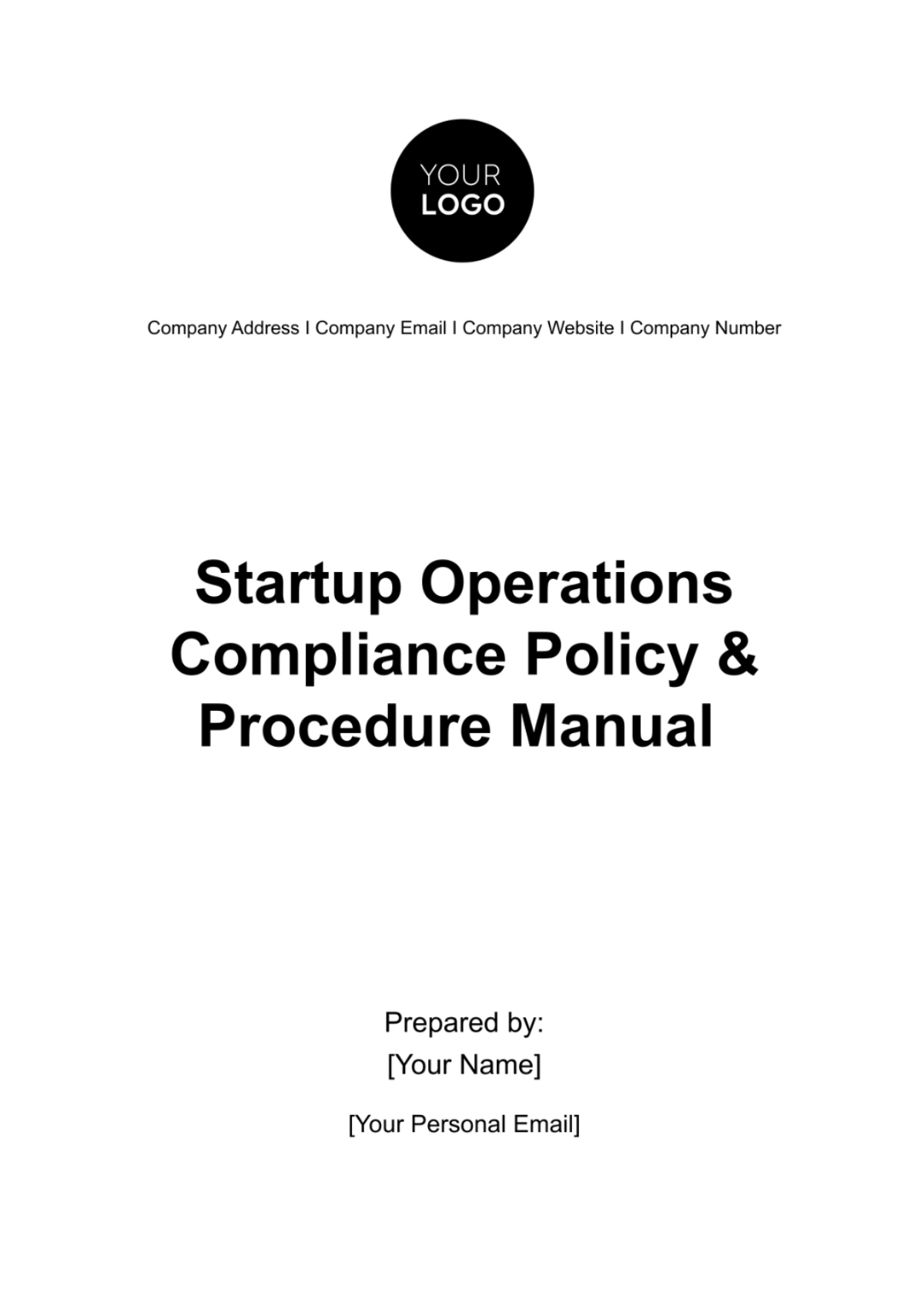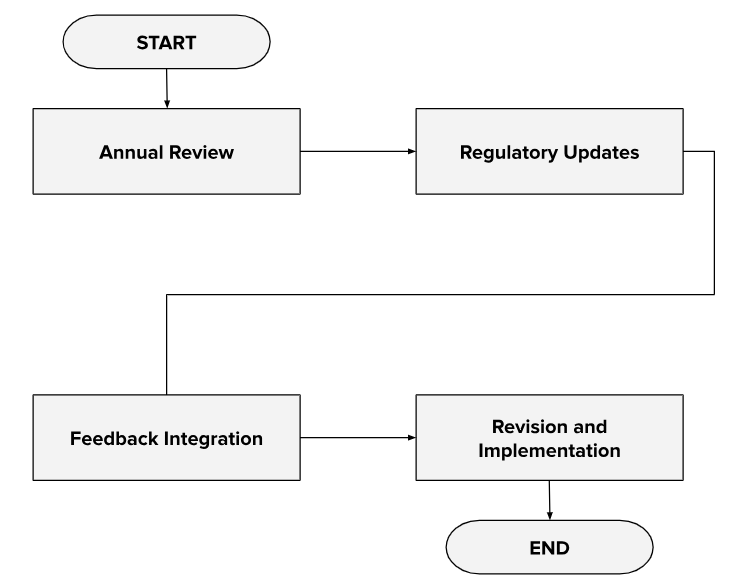Free Startup Operations Compliance Policy & Procedure Manual

1. Introduction and Purpose
Welcome to the [Your Company Name] Operations Compliance Policy & Procedure Manual. This document serves as a comprehensive guide designed to ensure our business operations not only align with but also excel in adherence to applicable US laws, regulations, and industry standards. Our commitment to operational excellence, ethical conduct, and legal compliance forms the cornerstone of our company's values and operational framework.
The purpose of this manual is to establish a clear set of guidelines and procedures for all employees, from executive leadership to entry-level team members. It aims to foster a culture of transparency, accountability, and integrity within [Your Company Name]. By adhering to these policies and procedures, we safeguard our company against risks, enhance our operational efficiency, and maintain the trust of our clients, partners, and regulatory bodies. This manual is a living document, subject to regular updates to reflect changes in legislation, industry practices, and our own continuous improvement efforts.
2. Compliance and Legal Framework
All operations of [Your Company Name] abide by a robust compliance and legal framework, encompassing all relevant federal, state, and local laws, and industry-specific regulations. This includes:
Domain | Laws and Regulations |
|---|---|
Employment Law | Equal Employment Opportunity, Fair Labor Standards Act, etc. |
Industry Compliance | Industry-specific regulations as applicable. |
Data Privacy | General Data Protection Regulation, Local Data Protection Laws, etc. |
Financial Regulations | Sarbanes–Oxley Act, Dodd-Frank Act, etc. |
3. Organizational Structure and Responsibilities
The Organizational Structure and Responsibilities section of the [Your Company Name] Operations Compliance Policy & Procedure Manual delineates the hierarchy and specific compliance duties within our organization. This clarity ensures accountability and facilitates effective communication and enforcement of compliance policies across all levels of the company. Below is a representation of our organizational structure and the corresponding compliance responsibilities.
Position/Department | Compliance Responsibility |
|---|---|
Board of Directors | Oversee overall compliance strategy; approve major policies. |
CEO | Ensure company-wide commitment to compliance; ultimate responsibility. |
Compliance Officer | Develop, implement, and monitor compliance programs; training and audits. |
Human Resources | Ensure employment law compliance; manage employee training on compliance. |
Finance Department | Manage financial compliance, including tax obligations and reporting standards. |
Operations Department | Implement and monitor operational procedures; ensure regulatory compliance. |
IT Department | Safeguard data privacy and security; manage technology compliance. |
Marketing Department | Ensure advertising and promotions meet legal standards; social media compliance. |
Sales Department | Adhere to ethical sales practices; compliance with consumer protection laws. |
4. Code of Conduct
The Code of Conduct section articulates the ethical standards and professional behaviors expected of every individual at [Your Company Name]. It is foundational to our corporate integrity, guiding our decisions and interactions with colleagues, clients, and partners. This code ensures a respectful, safe, and inclusive workplace, underpinning our commitment to excellence and ethical business practices.
Principle | Expectation |
|---|---|
Integrity | Conduct all business honestly, transparently, and honor commitments. |
Respect | Treat all individuals with dignity, valuing diversity and inclusivity. |
Accountability | Take responsibility for actions and decisions, including admitting mistakes. |
Compliance | Adhere strictly to legal standards and company policies. |
Confidentiality | Protect sensitive information and respect privacy laws. |
Fairness | Engage in fair competition and avoid conflicts of interest. |
Sustainability | Promote environmental responsibility and sustainable practices. |
Community Engagement | Contribute positively to our communities and respect cultural norms. |
5. Operational Policies and Procedures
The Operational Policies and Procedures section provides detailed guidelines for essential business functions, ensuring compliance with best industry practices and legal compliance in areas, such as:
Financial Management
Human Resources
Data Protection
Privacy Policy
6. Risk Management
Risk Management is a critical component of [Your Company Name]'s strategic framework, designed to identify, assess, and mitigate potential risks that could impact our operations, reputation, or financial stability. Our approach to risk management is proactive and comprehensive, ensuring we remain resilient and adaptable in a rapidly changing business environment.
Risk Identification: Systematically identifying potential risks across all areas of operation.
Risk Assessment: Evaluating the likelihood and potential impact of identified risks.
Mitigation Strategies: Implementing measures to minimize or eliminate risks.
Monitoring and Review: Continuously monitoring risk factors and the effectiveness of mitigation strategies, adjusting as necessary.
Crisis Management: Preparing for and responding to unforeseen crises or emergency situations.
Compliance Risks: Ensuring adherence to legal and regulatory requirements to avoid legal penalties and financial losses.
Operational Risks: Managing risks related to internal processes, people, and systems.
Financial Risks: Protecting assets from market fluctuations, fraud, and other financial risks.
Reputational Risks: Safeguarding [Your Company Name]'s public image and stakeholder trust.
7. Training and Education
Training and Education are pivotal in [Your Company Name]'s commitment to fostering a knowledgeable, compliant, and skilled workforce. Our comprehensive training programs are designed to equip employees with the understanding and tools necessary to perform their roles effectively while adhering to legal standards and company policies.
Orientation Programs: Introducing new hires to our company culture, policies, and procedures.
Compliance Training: Regular sessions on legal requirements, ethical conduct, and industry-specific regulations.
Skill Development: Enhancing professional skills relevant to each employee's role and career progression.
Leadership Training: Preparing future leaders with management skills and strategic thinking.
Safety and Emergency Procedures: Ensuring employees are prepared for health and safety protocols.
Technology and Software: Keeping staff updated on new technologies and software tools used in our operations.
Customer Service Excellence: Training on delivering outstanding service and handling customer feedback.
Continuous Learning: Encouraging ongoing education through workshops, seminars, and online courses.
8. Monitoring and Reporting
Monitoring and Reporting within [Your Company Name] are essential processes that ensure ongoing compliance and operational effectiveness. Our approach is rooted in transparency and accountability, employing both internal and external audits to rigorously evaluate adherence to policies, legal standards, and performance benchmarks. Regular monitoring activities are conducted across all departments, utilizing key performance indicators (KPIs) and compliance metrics to identify areas for improvement and to ensure that all operations align with our strategic goals and regulatory requirements.
Reporting mechanisms are in place to communicate findings from monitoring activities to senior management and relevant stakeholders. This includes the preparation of detailed reports on compliance status, audit results, and risk management efforts. [Your Company Name] encourages an open-door policy for reporting concerns or violations, ensuring that employees feel supported in upholding our company's ethical standards. Through these processes, we foster a culture of continuous improvement, enhancing our operational resilience and maintaining the trust of our clients, partners, and the regulatory community.
9. Incident Management and Disciplinary Action
In the event of a compliance breach, [Your Company Name] is committed to a structured and fair approach to incident management and disciplinary action. Our procedure begins with a prompt and thorough investigation to understand the nature and extent of the breach. A designated team, typically led by the Compliance Officer, gathers information, interviews relevant personnel, and documents findings. This process ensures that all actions are based on accurate and comprehensive data, maintaining fairness and confidentiality throughout.
Upon concluding the investigation, the findings are reported to senior management, who will determine the appropriate disciplinary action in accordance with our company policies and the severity of the breach. Actions may range from verbal warnings to termination of employment, depending on the nature of the violation. [Your Company Name] is dedicated to enforcing these measures consistently across all levels of the organization, emphasizing the importance of compliance and ethical conduct. This approach not only addresses the immediate issue but also reinforces our culture of accountability and integrity.
10. Review and Update of Policies
At [Your Company Name], we recognize the importance of keeping our policies and procedures not only compliant but also reflective of the latest industry standards, legal requirements, and operational best practices. As our business environment and regulatory landscapes evolve, so must our guidelines. This ensures that we continue to operate with integrity, efficiency, and in alignment with our commitment to excellence. To maintain the relevance and effectiveness of our policies, we adhere to a systematic process for reviewing and updating our compliance manual and related documents.

- 100% Customizable, free editor
- Access 1 Million+ Templates, photo’s & graphics
- Download or share as a template
- Click and replace photos, graphics, text, backgrounds
- Resize, crop, AI write & more
- Access advanced editor
Streamline your startup's operations and ensure compliance with the Startup Operations Compliance Policy & Procedure Manual Template from Template.net. This comprehensive template is fully editable and customizable, allowing you to adapt it to your startup's specific operational standards and regulations. Designed for ease of use in our Ai Editor Tool, it sets the foundation for solid operational practices and compliance.





























